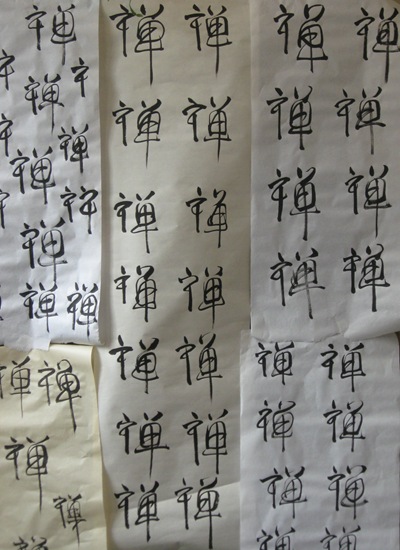Haven’t I heard somewhere something about “Do not pursue the past. Do not lose yourself in the future. The past no longer is. The future has not yet come”? Yes, well.
With as much mindfulness and concentration I could muster, I laid out my ink and paper, my roll of brushes. I filled my water container and poured out some ink. I balanced an Orchid-Bamboo brush on the edge of the water container just so, to soak the brush hairs but not the glue in the tip of the handle that holds the hairs in place. Mr. Choey was playing his usual tape of Chinese classical music, and I tried to let the calm mood of the room become my mood.
Mr. Choey called us up to the front to demonstrate some calligraphy, which is how he always starts the class. “Calligraphy is the first art,” he says, “higher art than painting.” We watched him demonstrate some simple characters, such as “man” or “person"

and more complex characters, such as “spring.”

He showed these in standard script. There are other styles of script which he sometimes shows us, including “running” style. “Running” style (cao shu) is to standard style (kai shu) as Western script penmanship is to printed handwriting. It is looser, more spontaneous and expressive, but must still follow certain rules in order to be readable as a particular character. You can’t just do messy standard script and call it running script. Another student and I are interested in practicing the “running” style of calligraphy, and we asked him to show us a character. He chose “zen,” or “meditation.”
In standard script, “meditation” looks like this:

Mr. Choey’s “meditation” (chán) in running script looked like this:

(Ignore the straight diagonal line from the upper right – he made this example over the tail end of one of my attempts.)
As he wrote the character several times, he explained the meaning of the ideogram. On the left is the radical form of the character meaning “god,” “sacred,” “holy.” He said that in this case, it means “mind,” because in Buddhism, the mind is the god of the body. [“We are what we think. All that we are arises with our thoughts. With our thoughts we make the world.”] On the right is the character meaning “single.” Together they mean “single-mind,” which is meditation. Your mind on one thing.
I set my mind on one thing: trying to get into the groove of this character, trying to tap into chi the way that Mr. Choey had. I wrote this character over and over and over. At some points, Mr. Choey would come by and say, “Getting better.” Once he took the brush from my hand and showed me again how to do it. (That example is what you see above, now pasted into my notebook.) Or he’d say, “This part should be bigger.”
Something happens when you practice a character over and over and over.

[click on picture for a larger view]
I grew more and more focused on the color and texture of the ink on the paper. I noticed how the paper took the ink from the brush depending on how quickly and confidently I moved the brush. I noticed also my own bad habits, and how hard it was to change them – I wanted the body of the left side to be bigger, but I found it nearly impossible to do it differently. I noticed how, as I got tired, a tendency to blame the brush crept in, even though it was the very same brush that Mr. Choey had used when he made me my own personal example. Habit energy is strong. And yet I felt exhilarated. But at the same time, calm. I no longer felt troubled by trouble.
It was only when I took a break and sat down, and considered whether to start working on a different character before we switched to painting, that the meaning of the character I had been working on really hit home. Single mind. Meditation. Working on the character had brought me that fruit – single-mindedness. And the fruit of that single-mindedness – meditation – had been a clear, calm mind.
“Looking deeply at life as it is, in the very here and now, the practitioner dwells in stability and freedom.”
That guy the Buddha knew what he was talking about.

Bhaddekaratta Sutta
translated by Thich Nhat Hanh
The Buddha taught:"Do not pursue the past.Do not lose yourself in the future.The past no longer is.The future has not yet come.Looking deeply at life as it is,in the very here and now,the practitioner dwells in stability and freedom.We must be diligent today.To wait until tomorrow is too late.Death comes unexpectedly.How can we bargain with it?The sage calls a person who knowshow to dwell in mindfulness night and day'one who knows the better way to live alone.'"
* * *
P.S. Mr. Choey's explanation of the meaning of the ideogram for meditation is very similar to this one by etymologist Adrian Chan-Wyles, who is a teacher in England in the Ch'an Buddhism tradition. Crudely excerpted:
Dhyana (यान) is represented by the Chinese character 禪, pronounced ‘Ch’an’. The Chinese ideogram has two particles.
The left hand particle is:
礻
This particle represents an ‘altar’, and is derived from the character 示 (shi4). This represents a person kneeling at a shrine, showing both respect and reverence. ...
The right hand particle of the ideogram for Ch’an is:
單
Interestingly, as a distinct character in its own right, this word, pronounced ‘dan’, has two relevant meanings. The first is that of a net, used to capture animals in the old days, whilst the second meaning refers to an individual – that is a single person – and carries the implication of ‘isolation’, or ‘aloneness’. ...
Taken together, the two particles that create the Chinese word ‘Ch’an’ carry the meaning of a spiritual or religious activity (the altar), often performed in isolation, that involves the gathering of scattered thought (symbolised by wild animals), through a one-pointed concentration of the Mind, represented by a net.
You can read the whole of his explanation on-line here.
P.P.S. Of all my Single Minds, if I had to pick one, I'd pick this one, even though it's not quite right.



